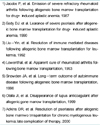Abstract
Stem cell therapy is providing a new paradigm of medical approach in many intractable diseases by regenerating injured or degenerated tissues and is opening the era of regenerative medicine. While the validity of newly discovered multipotentiality of various stem cells are still under investigation, scientists are making a significant progress in the medical application of stem cell therapy in the area of adult stem cell therapy, particularly using the hematopoietic and mesenchymal stem cells. These hematopoietic stem cells could be useful in cell therapies for liver diseases, heart diseases and neuronal diseases. Furthermore, due to their ability to induce donor-specific immune tolerance, these cells can be used in organ transplantation and autoimmune diseases. With further development of a high-performance cell therapeutic strategy, more intractable disease will be managed by stem cell therapy.
References
1. Clarke DL, Johansson CB, Wilbertz J, Veress B, Nilsson E, Frisen J, et al. Generalized potential of adult neural stem cells. Science. 2000. 288:1660–1663.

2. Krause DS, Theise ND, Collector MI, Henegariu O, Hwang S, Sharkis SJ, et al. Multi-organ, multi-ineage engraftment by a single bone marrow-derived stem cell. Cell. 2001. 105:369–377.

3. Lagasse E, Connors H, Al-Dhalimy M, Reitsma M, Dohse M, Grompe M, et al. Purified hematopoietic stem cells can differentiate into hepatocytes in vivo. Nat Med. 2000. 6(11):1229–1234.

4. Terada N, Hamazaki T, Oka M, Hoki M, Mastalerz DM, Scott EW, et al. Bone marrow cells adopt the phenotype of other cells by spontaneous cell fusion. Nature. 2000. 416:542–545.

5. Ying QL, Nichols J, Evans EP, Smith AG. Changing potency by spontaneous fusion. Nature. 2002. 6:1229–1234. in vivo Nat Med.

6. Jang YY, Collector MI, Baylin SB, Diehl AM, Sharkis SJ. Hematopoietic stem cells convert into liver cells within days without fusion. Nat Cell Biol. 2004. 6:532–539.

7. Alison MR, Poulsom R, Jeffery R, Dhillon AP, Quaglia A, Wright NA, et al. Hepatocytes from non-hepatic adult stem cells. Nature. 2000. 406:257.

8. Orlic D, Kajstura J, Chiment S, Limana F, Jakoniuk I, Anversa P, et al. Mobilized bone marrow cells repair the infarcted heart, improving function and survival. Proc Natl Acad Sci USA. 2001. 98:10344–10349.

9. Orlic D, Kajstura J, Chimenti S, Jakoniuk I, Anderson SM, Bodine DM, et al. Bone marrow cells regenerate infarcted myocardium. Nature. 2001. 410:701–705.

10. Kocher AA, Schuster MD, Szabolcs MJ, Takuma S, Burkhoff D, Itescu S, et al. Neovascularization of ischemic myocardium by human bone-marrow-derived angio-blasts prevents cardiomyocyte apoptosis, reduces remodeling and improves cardiac function. Nat Med. 2001. 7:430–436.

11. Mezey E, Chandross KJ, Harta G, Maki RA, McKercher SR. Turning blood into brain: cells bearing neuronal antigens generated in vivo from bone marrow. Science. 2000. 290:1779–1782.

12. Brazelton TR, Rossi FM, Keshet GI, Blau HM. From marrow to brain: expression of neuronal phenotypes in adult mice. Science. 2000. 290:1775–1779.

13. Hofstetter CP, Schwarz EJ, Hess D, Widenfalk J, El Manira A, Olson L, et al. Marrow stromal cells form guiding strands in the injured spinal cord and promote recovery. Proc Natl Acad Sci USA. 2002. 99:2199–2204.

14. Li Y, Chen J, Wang L, Lu M, Chopp M. Treatment of stroke in rat with intracarotid administration of marrow stromal cells. Neurology. 2001. 56:1666–1672.





 PDF
PDF ePub
ePub Citation
Citation Print
Print






 XML Download
XML Download